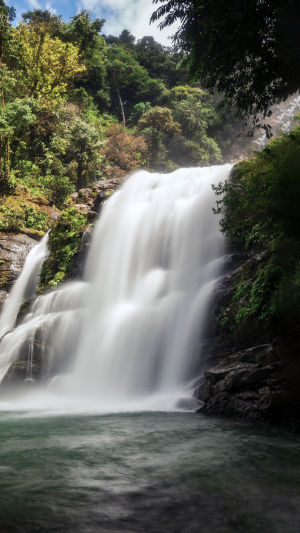Waterfalls, with their majestic and thunderous cascades, stand as some of Earth's most awe-inspiring natural wonders.
They interrupt the smooth curvature of river channels, displaying the progression of erosion processes. Various factors contribute to the formation of waterfalls, each unique to different regions.
1. Inconsistencies in rock hardness within riverbeds create steep drops, with softer rocks eroded and harder ones forming overhangs, resulting in waterfall formation. Niagara Falls, situated at the border of the USA and Canada, showcases a striking example, with a layer of hard limestone over softer shale and sandstone.
The relentless erosion by the Niagara River cascading over the limestone cliff continuously undermines the shale, hollowing out the limestone caves, and leading to perpetual cliffs and the iconic Niagara Falls.
2. Ancient volcanic activity could produce molten rock that solidified over time to form barriers within river channels. Alternatively, volcanic eruptions could block rivers, forming lakes, and overflow, resulting in waterfalls. Also, water accumulation in volcanic craters forming lakes, overflowing through gaps, can create waterfalls. For instance, waterfalls from Mount Baekdu were formed in this manner.
3. Ancient glaciers carving into valleys, creating cliffs on either side, subsequently occupied by rivers, lead to waterfall formation. As rivers flow through these valleys with significant depth variations, waterfalls emerge. Additionally, tectonic movements raising plateaus with rivers at their edges contribute to waterfall creation. Yosemite Falls in California, carved by glacial action, plunges from a hanging valley of 436 meters.
In some cases, erosion from water flow retreats the position of waterfalls upstream due to cliffs or steep gradients. Alternatively, erosion tendencies may incline toward a deeper incision downwards, cutting through the entire river segment containing the waterfall.
Over time, these factors inevitably cause any potential waterfall to disappear, eventually resulting in a relatively smooth, upwardly concave longitudinal profile. Even in the absence of gravel used for river erosion, the energy for waterfall-based erosion is substantial.
Characteristic of waterfalls, regardless of size or flow, one feature is the presence of plunge pools below the cascade. These pools are eroded basins in the riverbed beneath the waterfall. In some cases, the depth of these plunge pools may approach the height of the waterfall's cliff. Ultimately, plunge pools lead to the collapse of cliff faces and the retreat of waterfalls.
The cliffs responsible for waterfalls continuously collapse under the forceful impact of water flow, leading to the upstream retreat and decreased height of waterfalls, ultimately causing their disappearance. Waterfalls, as nature's masterpieces, captivate with their magnificent force and infinite vitality. Globally, numerous renowned waterfall landscapes, each with distinct characteristics, attract thousands of tourists seeking their breathtaking beauty.





